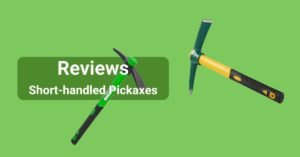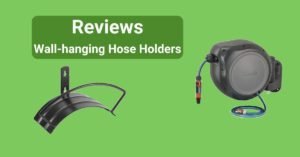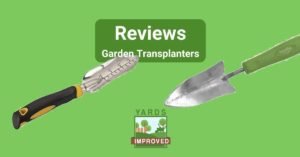Gardeners have a few enemies, but weeds rank near the top of the most-hated list. Keeping them out of the garden, and getting rid of them when they do sneak in, is a job that never ends. There are several fronts to fight this battle on, but one essential element is a garden weeder.
What A Weeder Does
There are many types of weeder, but all are designed to pull a weed up by the roots. They attack the unwanted plants at the soil level and try to pull out as much of the roots as possible.
It Takes All Kinds
The term “weeder” generally refers to short-handled tools that you would use kneeling or sitting in your garden. Often, they are shaped like a fork with two or three prongs.
Of course, other tools may perform a similar or related function. A stirrup hoe generally has a longer handle but works similarly. Other types cut the weed off at the soil level, which can provide short-term relief.
You may even use a trowel to dig up the weed completely.
Of course, weed killers are a close ally in this unending campaign for control of your garden.
For this article, we’re going to focus on the short-handled tools that pull out the
What To Look For In A Weeder
A weeder is almost a brute-force tool, but there are still a few things to consider when making your choice. Here’s what you should look out for:
Suitable Form
Even with our limit on the type of garden weeder we’re looking at here, there’s still a lot of variety.
Some have two small prongs that go on either side of the weed to pull it from below. If you know your weeds rely on a root that goes straight down, this is a good option.
Others have three prongs and try to grab the weed from above, holding on to the leaves to get a good grip on the plant. For weeds with thicker leaves that spread out closer to the ground, you might like this style.
And some drag the weed out with a straight edge, similar to a hoe. This is great for weeds with shallow roots, like crabgrass.
Ease Of Use
One of the problems with short-handled tools is that your hands sometimes get in the way. You might find yourself bumping your knuckles on the ground, or having trouble holding the tool at the right angle.
This depends on a lot of factors, including the size of your hands, the area where you have to pull weeds, and personal preference, so we’re not going to give specific recommendations. But we encourage you to think about all that before making your choice.
Also, keep in mind the type of weeder and the space in your garden. Some weeders are very narrow, so they’re great at getting into tiny spaces between your vegetables or flowers. Others are wider, so they work better in open spaces.
Comfort
Of course, you want to feel comfortable using all your tools. The handle should feel good in your hand, especially since you’ll be doing a lot of pulling (and sometimes pushing) with your garden weeder.
A padded grip is always a plus. The same can be said for a lightly contoured handle.
Our Picks For The Best Weeders
We think you’ll find any of these weeders a great addition to your gardening supplies. Here’s some information and things to look for in each one.
Betus Manual Hand Weeder
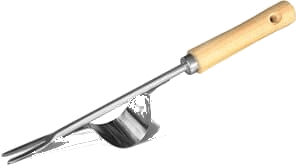
This two-prong weeder has a unique design that caught us off-guard. Remember how we mentioned scraped knuckles being a potential issue? Well, this tool does its best to eliminate that possibility!
Along the handle, there’s a “knuckle guard” that also provides leverage when you’re pulling up weeds by the roots. It serves as a pivot so that your hand stays away from the ground. Simply put the fork around the stalk, and push down on the handle.
It’s great for weeds like dandelions that have a strong taproot that it can grab ahold of. It’s also narrow – even with the knuckle guard – so you’ll be able to get it into tight spaces without an issue.
The wooden handle is satisfactory, although nothing special. Overall, the tool is sturdy. It’s just that the handle lacks any contours, so it’s not always the most comfortable piece to work with.
Fiskars 339950-1002 4-Claw Weeder
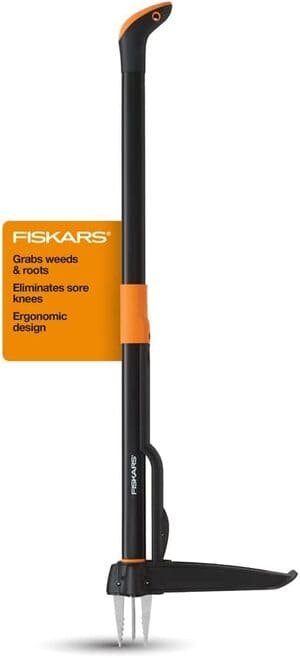
This is a unique weed remover. Unlike other ones on our list, it can be used while standing, since it measures 39 inches long.
Simply press this down over the weed, and the four prongs will wrap around the roots. Pull the tool up, and the entire week should come with it.
This is another great choice for weeds with tough taproots since the prongs are designed to go straight down.
In general, this tool works well, although you have to be careful not to force it when there might be rocks present. Also, since it – unlike other weeders – has moving parts, it’s more at risk to break, even with regular use.
Overall, it’s a good idea that works decently well most of the time. With some care, it could be a good addition to your tool set. But it costs a decent amount of money, and you may choose not to risk that, even from a reputable brand like Fiskars.
Fiskars Ergo Scratch Tool Garden Weeder
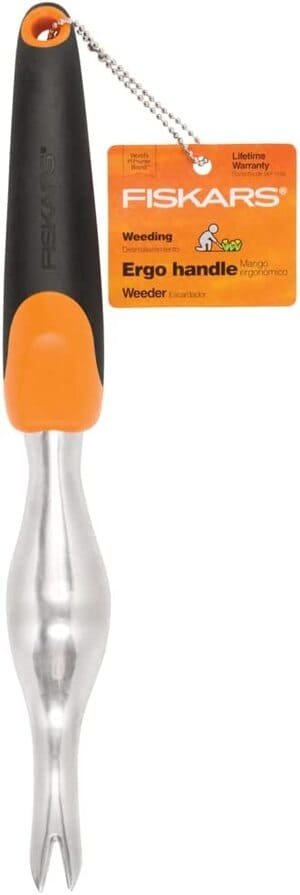
Fiskars also offers this more traditional two-prong weeder. If you want to stick with something more traditional than their 4-claw weeder above, this one is highly recommended.
It has a small bend near the fork to help provide leverage and protect your hand, although we would like something a tiny bit larger. This does help a bit, but not much.
However, we like everything else about this piece. It’s solidly built – both the fork and the handle are durable. The handle is also contoured and will fit well in most people’s hands. The fork is made of cast aluminum, making it strong and rust-resistant.
Like other two-prong weeders, it’s best for weeds with deep taproots.
HACHIEMON Japanese Weeding Tool
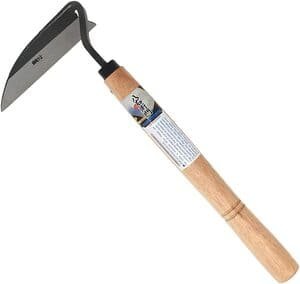
This tool stands out because of its ability to cut right through weeds and get your garden in good shape.
It works by dragging the 4.8-inch-wide blade across the ground and pulling the weed up as you drag it. The blade is steel, so it’s strong, and its tang reaches well into the wooden handle, so it stays together well.
The blade is sharp and holds its edge well, although over time you may find that it needs to be sharpened.
One drawback of this is that it’s “handed” – that is, it’s designed specifically for right-handed people. If you’re a leftie, it’s manageable, but not as easy. However, they do have a left-handed version available!
It’s a sturdy tool that can even be used for close-up edging.
Berry & Bird Crack Weeder
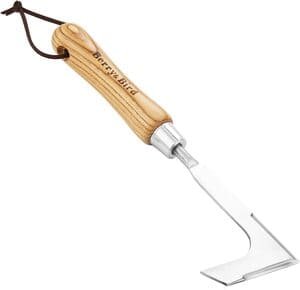
This crack weeder works best for exactly what the name says: get weeds out of cracks in cement, along foundations, or between boards. But it can also be used to pull up weeds that have smaller root systems like crabgrass.
The blade is a hair under 2 ½ inches wide, and the entire tool is about 11 ¼ inches long. That makes it great for getting into tight spots, whether along walls or other obstacles or between the plants you want to protect.
The blade also has two sharp sides – on the bottom and parallel to the handle. That makes it even easier to cut off weeds at the root, no matter where they’re growing.
The handle is ash and the blade is stainless steel.
Conclusion
The right tools – including a garden weeder – are essential in keeping your garden weed-free. Be sure to choose one that works well against the weeds you’re dealing with and that’s easy to use. It’s tough work, but it pays off with beautiful flowers and produce from your backyard!



